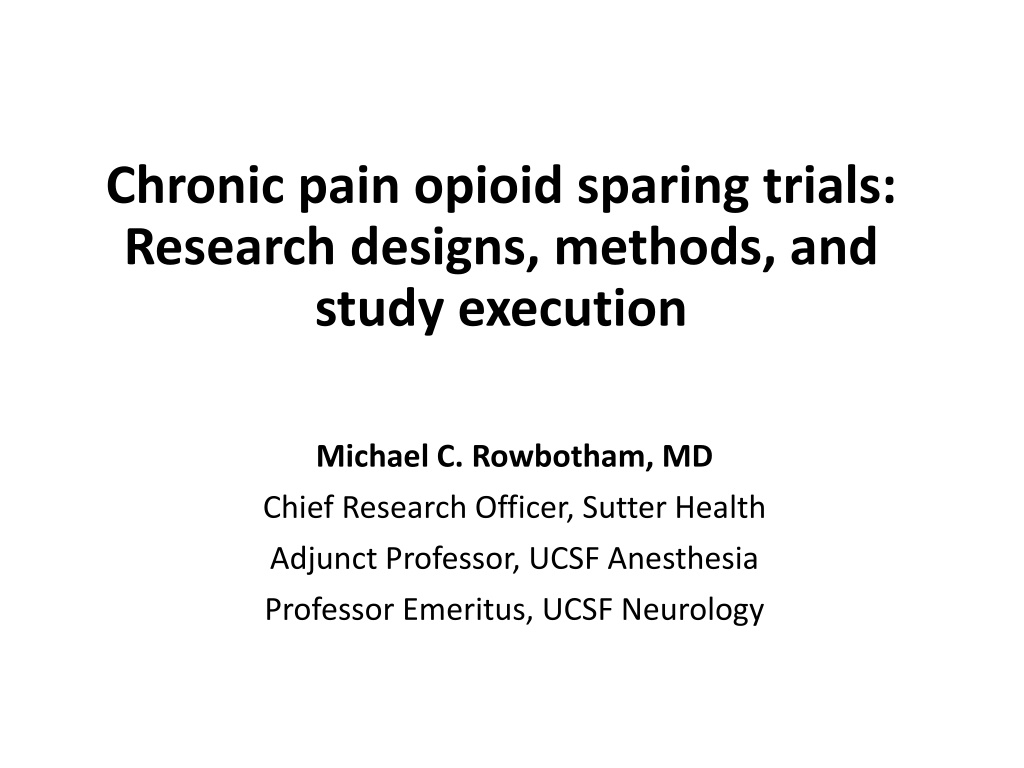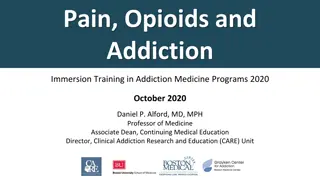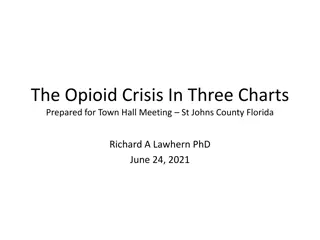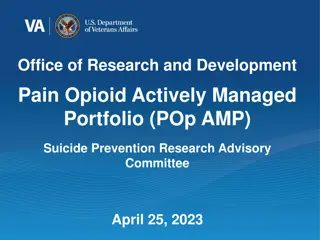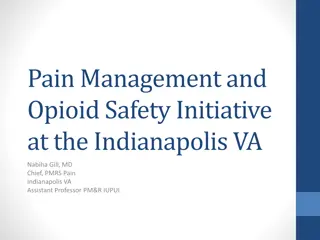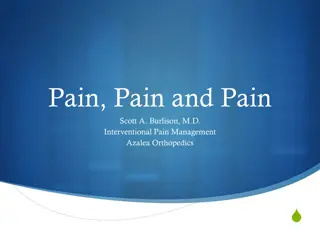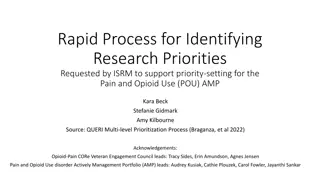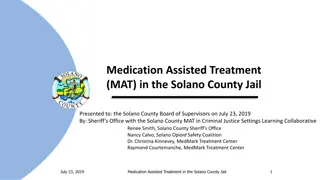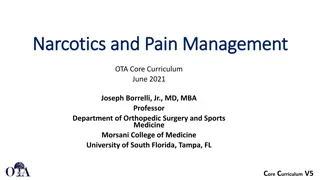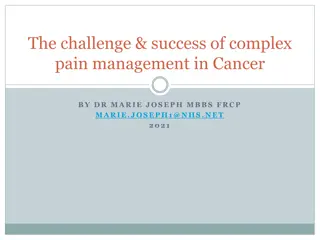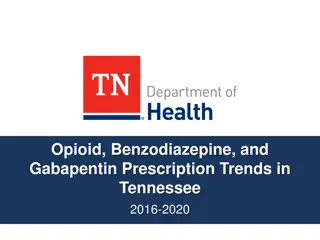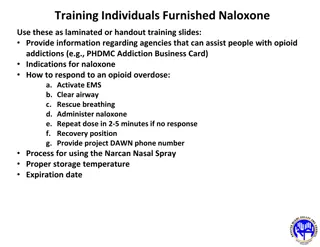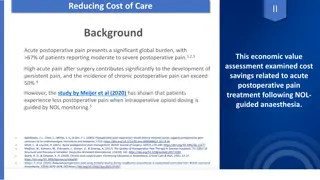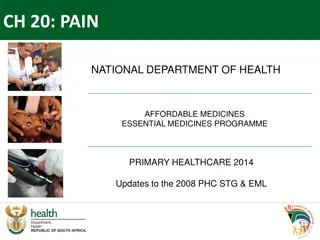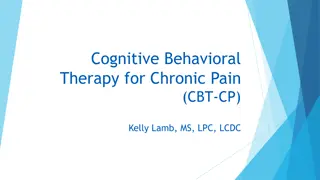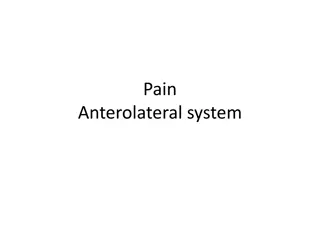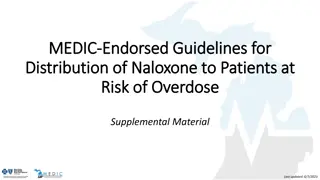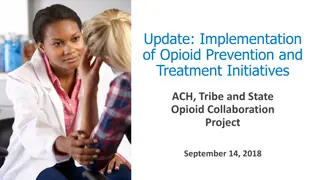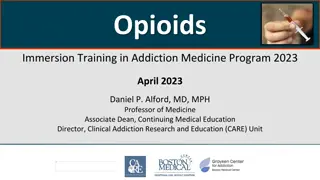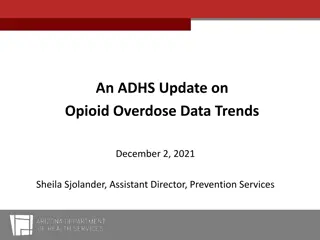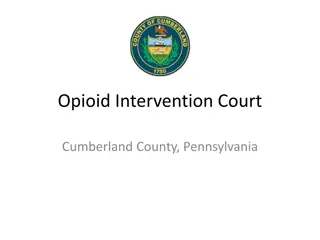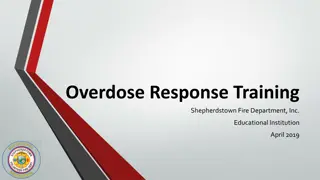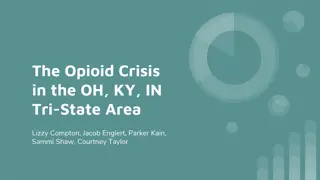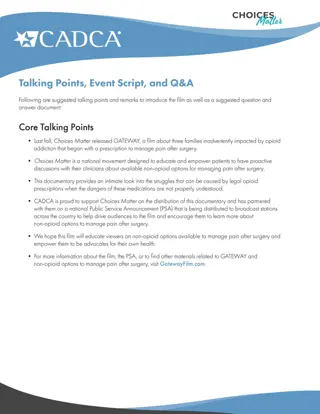Exploring Opioid Sparing Strategies in Chronic Pain Management
This collection of research insights delves into the concept of opioid sparing in chronic pain management, highlighting the potential benefits of lower opioid doses, reduced need for opioids, and mitigating risks associated with opioid use. It discusses the challenges of opioid tapering, patient responses to opioid treatments, and outcomes of various opioid sparing trials. The content also touches upon the Cowan study from the UK, the implications of treating patients with opioids, and the response to treatment trials in epilepsy.
Uploaded on Sep 27, 2024 | 0 Views
Download Presentation

Please find below an Image/Link to download the presentation.
The content on the website is provided AS IS for your information and personal use only. It may not be sold, licensed, or shared on other websites without obtaining consent from the author. Download presentation by click this link. If you encounter any issues during the download, it is possible that the publisher has removed the file from their server.
E N D
Presentation Transcript
Chronic pain opioid sparing trials: Research designs, methods, and study execution Michael C. Rowbotham, MD Chief Research Officer, Sutter Health Adjunct Professor, UCSF Anesthesia Professor Emeritus, UCSF Neurology
What does opioid sparing mean and what are the outcomes to measure? Lower doses of opioids Can also mean sparing the need for opioids Could even mean sparing or reducing the frequency of OUD or reducing risk of overdose severe outcomes like hospitalization and death Could be reinterpreted to mean opioid dose optimization (per HLF comment) Lack of agreement on goals and outcome measures
What I learned about opioid tapering before my residency in Neurology ....... Chiang Mai, Thailand, UCSF Medical Student 1979 SFGH Methadone Clinic Medical Director 1981-83 Hard to reduce dose, dose escalation can be surprisingly rapid
Cowan study (UK) Cowan DT, et al, Pain Medicine 2003; 4:340-51. N=104 prescribed opioids for mean of 14 months 2.8% addiction rate (but use could still be managed) 90 of 104 reported stopping opioids at some point - only 13 reported withdrawal sx 31 stopped temporarily; 59 stopped permanently Temporary cessation due to fear of addiction in 22% Permanent cessation due to fear of addiction in 10%, neuropsych AEs 23%, tx failure 18%
Are patients treated with opioids inherently different? Yes, if opioids always a last resort Response to sequential treatment trials and duotherapy in epilepsy Kwan and Brodie, NEJM 2000; 342:314-319 Likelihood of success no different if first drug old vs new Thank you to Ken Laxer
Response to sequential treatment trials and duotherapy in epilepsy 2011 update from the Glasgow group N > 1,000 subjects Failure rate reduced from 36% to 32% Brodie and Sills, Seizure 2011; 20:369-375
What could a device accomplish? Pain relief and symptom control The device prevents the need to initiate opioids A direct pain-relieving effect The device plus opioids is associated with equivalent pain relief at a lower opioid dosage than opioids alone Either directly relieves pain or synergistic with opioids The device makes it possible to taper down to a lower dosage or even completely discontinue -- in patients already on opioids Either directly pain relieving, or synergistic with opioids, or targets symptoms of opioid withdrawal The device makes it possible to receive opioids in a form less prone to abuse No requirement of pain relief or synergy Could be transdermal absorption, iontophoretic, intraspinal, PCA Examples would include spinal cord stimulation, deep brain stimulation, spinal drug delivery, withdrawal or craving symptom driven non-opioid drug delivery device, etc.
Prevention of OUD Monitoring or lock-out The device prevents the development of OUD in patients on opioids Not really sparing, but prevents unsanctioned dose escalation Tamper-proof system for ensuring dose limits can t be exceeded (analogous to ambulatory PCA) Would need to also ensure patient not taking other opioids or taking same opioid by multiple routes The device prevents opioid diversion in patients on opioids Not really sparing, but relevant to the societal problem Device would confirm patient actually taking the prescribed opioid and not diverting it
Would an app qualify? How about device-delivered behavior modification? Like a digital friend, AA support member, or family, delivers messages of support to reduce craving and unsanctioned opioid use Pear Therapeutics MIT Media Arts and Sciences Program developing multiple devices to alter attitude and decision making (Pattie Maes) Change the valence of the situation Odor release Pairing drug use with negative beliefs of patient s choosing (aversive conditioning)
Trial design issues: Historical Controls Not useful or valid Society and prescribers have moved from an opioid-promoting to an opioid-averse culture Is OUD associated with higher opioid doses? Does this mean that lower doses confer lower OUD? Time delay between post-op pain management and OUD long and variable why? Prescribers are now prescribing significantly lower doses of opioids and being more selective in who receives them Not necessarily due to introduction of buprenorphine What constitutes a high risk patient is better appreciated by prescribers Paradoxical increase in use of illicit opioids with associated increased risk of overdose Prescription opioids less easily obtained Only a prospective study can settle the issue
Trial design issues: prospective RCT If goal is opioid sparing, depending on outcome measure, trial length could vary dramatically Opioid use at 1 month = easy Opioid use at 3 months = feasible Opioid use at 6 months or longer = very difficult due to drop out rates of 50% or more and difficult recruitment If goal is reduced incidence of OUD, a traditional RCT is almost impossible without complete control over opioid Rx and perfect monitoring this is not a short-term outcome Entirely dependent on assumptions about what % develop OUD Skewing the population towards higher OUD risk (hx of mental illness, stimulant abuse hx, etc) reduces sample size but makes study execution vastly more difficult Case-Control design as an alternative If a device compared to best medical therapy, then only works well if device not otherwise readily available Cohort designs covered as a form of pragmatic trial
Prospective RCTs - all about recruitment and retention Costly, hard to recruit subjects High OUD risk patients hardest to recruit, usually left out Opioid trials have the highest drop out rates of all? Drop outs are almost certainly failures AEs exceed perceived benefit
Levorphanol for Peripheral and Central Neuropathic Pain: Low- vs High-Strength Levorphanol Capsules Randomized, Double-Blind Comparison Baseline Week Tapering Week 1 Tapering Week 2 Tapering Week 3 Tapering Week 4 Screening Week 1 Week 2 Week 3 Week 4 Week 5 Week 6 Week 7 Week 8 Maximum, 3 capsules Maximum, 9 capsules Maximum, 15 capsules Maximum, 21 capsules Tapering (up to 4 weeks) Titration Treatment (maximum, 21 capsules) No opioids allowed Rowbotham et al. N Engl J Med. 2003;348:1223-1232
A Closer Look. 81 subjects randomized, 59 completed 15 drops due to AE s; agitation in high strength group Eventual drops fell behind in capsule intake, pain reduction, and pain relief No significant group difference in relief ratings Actual daily dose highly variable
Trial design issues: Pragmatic Trials Patients stay in their usual care situation Outcomes determined from review of EHR Correlations straightforward, but proof of causation difficult Data collection and correlation issues
Trial design issues: Pragmatic Trials EHR use is fraught with problems! Sutter Health has the world s largest installation of EPIC SF Bay Area has CareEverywhere to link multiple sources of care (UCSF, Sutter, Kaiser, others) Even at CPMC, private practice MDs in outpatient practices don t use EPIC Hard to get questionnaires in, even harder to get data back out
Trial design issues: Pragmatic Trials Cluster randomized design comparing treatment approaches prospectively This could be at the level of facility or practice (easy enough in a large integrated health care system like Kaiser or maybe Sutter) This could be at the level of state or country if opioids regulated differently, especially access to opioids Confounders and bias can be subtle Devices especially susceptible who gets access Busy primary care practices are different than dedicated pain management programs Outcome measures can be built into the electronic record Telemedicine and sensors would help Regular urine screening and other compliance measures too
